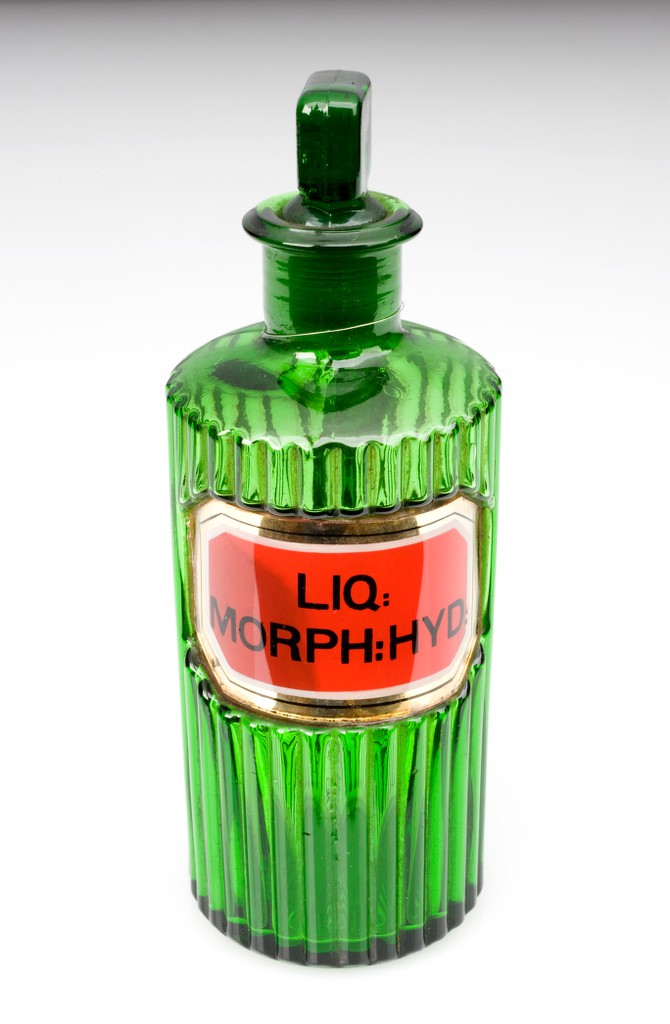Fatal Attraction: A Brief History of Morphine - a blog post from the Heritage Centre
Few of us could imagine living in a world without easy access to instant pain relief, may it be to soothe a headache or ease the pain of a sore toe. We expect to feel no pain during an operation, and afterwards we are supplied with pain medication as a matter of course. Today, safe medication can help us manage acute as well as chronic pain and thus lead a life that is not, temporarily or constantly, disturbed by the experience of pain.
The desire to live free of pain is universal among all living creatures, and humans have tried to find ways to alleviate pain since the dawn of man. Although many plants were used for their analgesic properties in the course of history, sleep-inducing poppies (papaver somniferum) were domesticated and cultivated as early as 5000BCE, likely making opium the first drug humans discovered. The ‘plant of joy’, as the opium poppy was denoted in Sumerian, had already been used medically for millennia even before the alkaloid morphine was isolated from raw opium in 1804. There is plenty of evidence that physicians in ancient Egypt and Rome regularly used it to relieve pain as well as calm the nerves. Emperor and philosopher Marcus Aurelius himself relied on an opium-based electuary compounded with honey to sleep most nights. (Perhaps that was the reason for his stoicism in the first place?)
The desire to live free of pain is universal among all living creatures, and humans have tried to find ways to alleviate pain since the dawn of man.
By the time apothecary’s assistant Friedrich Wilhelm Sertürner set out to isolate opium’s sleep-inducing factor in 1804, then, opium had seemingly been tried and tested, although habitual ‘opium eaters’ had become more common. Sertürner accomplished his goal working in his spare time, and eventually named the substance ‘morphium’ after the Greek god of dreams and sleep, Morpheus. Morphine, hailed as ten times more potent than opium, was first produced commercially in 1821, in a parlour behind a retail pharmacist’s shop in Farringdon Street. Fifteen years later morphine officially entered in the London Pharmacopoeia.
Although morphine was quickly accepted, it was the development of hypodermic syringes that made it one of the most popular drugs of the nineteenth century. Invented simultaneously but independently by physician Alexander Wood in Britain and surgeon Charles Pravez in France in 1853, the hypodermic syringe allowed for morphine to be administered by injection rather than orally. Wood reasoned that if the drug was injected rather than eaten, it would not create an appetite like other food and drink – a behaviour he had already observed in patients treated with opiates.

Opium poppies Wellcome Collection
Physicians everywhere rejoiced. From the 1860s onwards, morphine was given to anyone for anything; it appeared that the ailment that could not be remedied by hypodermic morphine did not exist. It reliably relieved the pain of those suffering from temporary or chronic illnesses, and calmed those in need of sleep. In 1868, Francis Anstie, founding editor of the periodical The Practitioner, confidently declared that “of danger there is absolutely none.”
It became evident that hypodermic morphine was not the magical panacea the medical world had hoped and believed it to be. Yes, it did bring peace and comfort to patients, but at a cost.
However, critical voices emerged even in the initial wave of enthusiasm. Already in the 1860s, Felix von Niemeyer, though conceding that “the introduction of hypodermic injections was a great event, and...an immense advance in treatment [for neuralgia],” warned that he clearly observed it creating addiction in his patients, who began “to feel an absolute need of the injections.” The following decade saw more and more practitioners come forward with their own observations. Physician Clifford Allbutt, who had effusively and publicly praised hypodermic morphine only a few months before, now reported its injurious effects on his patients: “They seem as far from cure as they ever were, they all find relief in the incessant use of the syringe, and they all declare that without the syringe life would be insupportable.”
It became evident that hypodermic morphine was not the magical panacea the medical world had hoped and believed it to be. Yes, it did bring peace and comfort to patients, but at a cost. The ‘disease’ of morphine addiction that was threatening society was spreading. For the first time, the question of culpability arose. Who was to blame?
In his important book Morbid Craving for Morphia (Die Morphiumsucht) of 1877, German physician Eduard Levinstein firmly stated that “the originators and propagators of this disease” were the medical men who freely prescribed hypodermic morphine for any old ailment, especially if they supplied patients with morphine and syringes, and left them to their own devices. However, doctors “must not be blamed for acting as they did,” Levinstein continued, “as it was done in the hope of affording relief to their patients, none of them thinking of the attendant danger.” This danger was only now being understood. It could, so he argued, happen to anyone – and it did; every echelon of society was affected. By 1888, the British Medical Journal (BMJ) even claimed that “the abuse of morphine has in many cases replaced the abuse of alcohol, especially in refined society.”
What could be done to combat this ‘morally dangerous disease’? For those already battling with addiction, Levinstein’s advice was to quit suddenly, as he found that his patients had generally overcome the withdrawal symptoms in two or three days.
By this time too, morphine addiction and the figure of the morphine addict was featuring prominently in literature as well as visual culture. Indeed, there was an outburst of morphine-themed art particularly in Paris, where artists were fascinated with portraying the female morphinée. These society women were said to routinely slip away during a theatre performance to indulge in their secret pastimes using bejewelled syringes and morphine bottles. Women did not become more easily addicted to morphine than men; yet, female addicts were often seen as particularly immoral, devoid of self-control, lying and even vicious, self-indulging in the pleasures morphine afforded. When Sir Lauder Brunton, however, recounted the case of a Member of Parliament who injected himself 24 to 32 grains of morphine daily – often secretly when in session, – he stressed that the MP only started this habit because his daughter was seriously ill, a reason which could be considered much more noble than seeking pleasure.
What could be done to combat this ‘morally dangerous disease’? For those already battling with addiction, Levinstein’s advice was to quit suddenly, as he found that his patients had generally overcome the withdrawal symptoms in two or three days. Writing a decade later, Oscar Jennings recommends the opposite approach of gradually reducing the morphine, eventually replacing morphine with other medicines such as sparteine and trinitrine. Both claimed successes in rehabilitating patients. For a brief time it was also believed that cocaine could be used to wean people from morphine.
But how to prevent addiction occurring in the first place? Anstie still believed morphine to be “one of the most valuable inventions of the country,” of the same significance as gaslight and the railway. As such it was too valuable to renounce completely; he simply recommended keeping the doses small. The BMJ emphasised that morphine should only be used by professional hands and advised keeping a record of the doses given. Moreover, morphine should only be given for fourteen days.

Liquid Morphine Science Museum
Nonetheless, morphine addiction remained prevalent. Even in the first decades of the 20th century, there were shops offering ‘buy one get one half-price’ injections in Germany. In Britain, too, real change only came with the Dangerous Drugs and Poisons (Amendment) Act of 1923. A year later, a Committee on Morphine and Heroin Addiction was set up. It concluded that, though morphine addiction was still more common than heroin addiction, both had become rare in Britain, which was attributed to the difficulty of obtaining drugs without medical prescriptions.
Morphine was both a blessing and a curse. It undeniably alleviated the physical and mental pain of many, but possibly caused as much pain and heartache in the process. Pain management has come a long way as medical professionals have striven to develop effective as well as safe pain medication.